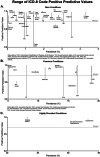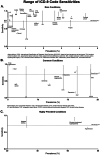Comprehensive review of ICD-9 code accuracies to measure multimorbidity in administrative data
- PMID: 32487087
- PMCID: PMC7268621
- DOI: 10.1186/s12913-020-05207-4
Comprehensive review of ICD-9 code accuracies to measure multimorbidity in administrative data
Abstract
Background: Quantifying the burden of multimorbidity for healthcare research using administrative data has been constrained. Existing measures incompletely capture chronic conditions of relevance and are narrowly focused on risk-adjustment for mortality, healthcare cost or utilization. Moreover, the measures have not undergone a rigorous review for how accurately the components, specifically the International Classification of Diseases, Ninth Revision (ICD-9) codes, represent the chronic conditions that comprise the measures. We performed a comprehensive, structured literature review of research studies on the accuracy of ICD-9 codes validated using external sources across an inventory of 81 chronic conditions. The conditions as a weighted measure set have previously been demonstrated to impact not only mortality but also physical and mental health-related quality of life.
Methods: For each of 81 conditions we performed a structured literature search with the goal to identify 1) studies that externally validate ICD-9 codes mapped to each chronic condition against an external source of data, and 2) the accuracy of ICD-9 codes reported in the identified validation studies. The primary measure of accuracy was the positive predictive value (PPV). We also reported negative predictive value (NPV), sensitivity, specificity, and kappa statistics when available. We searched PubMed and Google Scholar for studies published before June 2019.
Results: We identified studies with validation statistics of ICD-9 codes for 51 (64%) of 81 conditions. Most of the studies (47/51 or 92%) used medical chart review as the external reference standard. Of the validated using medical chart review, the median (range) of mean PPVs was 85% (39-100%) and NPVs was 91% (41-100%). Most conditions had at least one validation study reporting PPV ≥70%.
Conclusions: To help facilitate the use of patient-centered measures of multimorbidity in administrative data, this review provides the accuracy of ICD-9 codes for chronic conditions that impact a universally valued patient-centered outcome: health-related quality of life. These findings will assist health services studies that measure chronic disease burden and risk-adjust for comorbidity and multimorbidity using patient-centered outcomes in administrative data.
Keywords: ICD-9; Literature review; Multimorbidity; Validation.
Conflict of interest statement
The authors declare that they have no competing interests.
Figures



Similar articles
-
Multimorbidity measures from health administrative data using ICD system codes: A systematic review.Pharmacoepidemiol Drug Saf. 2022 Jan;31(1):1-12. doi: 10.1002/pds.5368. Epub 2021 Oct 19. Pharmacoepidemiol Drug Saf. 2022. PMID: 34623723 Review.
-
Implementing the US Department of Health and Human Services definition of multimorbidity: a comparison between billing codes and medical record review in a population-based sample of persons 40-84 years old.BMJ Open. 2021 Apr 24;11(4):e042870. doi: 10.1136/bmjopen-2020-042870. BMJ Open. 2021. PMID: 33895712 Free PMC article.
-
The accuracy of using administrative healthcare data to identify epilepsy cases: A systematic review of validation studies.Epilepsia. 2020 Jul;61(7):1319-1335. doi: 10.1111/epi.16547. Epub 2020 May 31. Epilepsia. 2020. PMID: 32474909
-
ICD-10-AM codes for cirrhosis and related complications: key performance considerations for population and healthcare studies.BMJ Open Gastroenterol. 2020 Sep;7(1):e000485. doi: 10.1136/bmjgast-2020-000485. BMJ Open Gastroenterol. 2020. PMID: 32943463 Free PMC article.
-
Systematic review and assessment of validated case definitions for depression in administrative data.BMC Psychiatry. 2014 Oct 17;14:289. doi: 10.1186/s12888-014-0289-5. BMC Psychiatry. 2014. PMID: 25322690 Free PMC article. Review.
Cited by
-
Effect of Obesity on Mortality in Pulmonary Hypertension-A Systematic Review and Meta-Analysis.J Cardiovasc Dev Dis. 2023 Oct 6;10(10):419. doi: 10.3390/jcdd10100419. J Cardiovasc Dev Dis. 2023. PMID: 37887866 Free PMC article. Review.
-
Comparing reliability of ICD-10-based COVID-19 comorbidity data to manual chart review, a retrospective cross-sectional study.J Med Virol. 2022 Apr;94(4):1550-1557. doi: 10.1002/jmv.27492. Epub 2021 Dec 8. J Med Virol. 2022. PMID: 34850420 Free PMC article.
-
Association Between Preexisting Heart Failure With Reduced Ejection Fraction and Fluid Administration Among Patients With Sepsis.JAMA Netw Open. 2022 Oct 3;5(10):e2235331. doi: 10.1001/jamanetworkopen.2022.35331. JAMA Netw Open. 2022. PMID: 36205995 Free PMC article.
-
The association of new-onset diabetes with subsequent diagnosis of pancreatic cancer-novel use of a large administrative database.J Public Health (Oxf). 2023 Jun 14;45(2):e266-e274. doi: 10.1093/pubmed/fdac118. J Public Health (Oxf). 2023. PMID: 36321614 Free PMC article.
-
Comparison of Propylthiouracil vs Methimazole for Thyroid Storm in Critically Ill Patients.JAMA Netw Open. 2023 Apr 3;6(4):e238655. doi: 10.1001/jamanetworkopen.2023.8655. JAMA Netw Open. 2023. PMID: 37067797 Free PMC article.
References
Publication types
MeSH terms
Grants and funding
LinkOut - more resources
Full Text Sources

